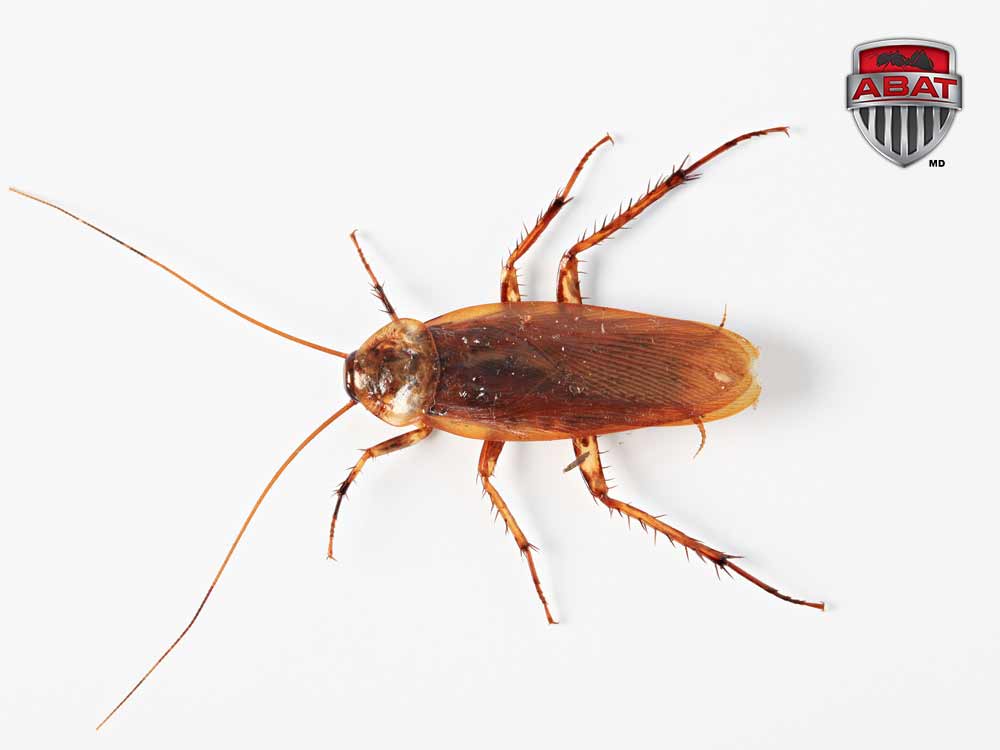| French name | Blatte américaine |
| English name | American cockroach |
| Latin Name | Periplaneta americana |
| Class | Insecta |
| Order | Blattodea |
| Family | Blattidae |

There are over 4,400 species of cockroaches throughout the world. The American cockroach is a species belonging to the family Blattidae (in Latin, Periplaneta americana) and is found both in Honduras and Central America. It is considered harmful because of the damage it causes in a home.
This cockroach breeds more readily in tropical countries such as most of Central America and in particular the Island of Útila.
Description and origins of the American cockroach
- The adult American cockroach is approximately 4 cm in length.
- Its body is reddish or orange-brown and its pronotum (thorax) has a transparent contour where two or a single large reddish brown spot is apparent.
- The adult male has longer wings than the female.
- The American cockroach moves mostly along the ground, but it can also fly over short distances.
- The nymph is wingless.
This insect is endemic in Africa and was brought into the United States of America during the 17th century. The cockroach proliferates in tropical regions, but it is now also present in cities as a result of international trading.
In residential areas, it lives in basements and sewers.
Inside homes, it is also found in cracks (including those in the basement) or in the sanitary facilities.
It is attracted by heat and humidity, but survives poorly or not at all in cold temperatures.
Tourists are at times inconvenienced by its undesirable presence, as its proliferation is facilitated by minimal hygiene and poor waste management often rampant in restaurants.
Throughout its life of 450 days, a female cockroach produces between 9 and 90 ootheca (a rigid egg pod or capsule) containing each 14 to 18 eggs.
This means that for each female insect, tens of thousands of offspring will be produced in record time.
Many developing countries in Central or South America (including Honduras) are affected by this scourge, and tourist islands are no exception.
- Intense heat begins at sunrise
- Humidity levels climb to 90%
- Insufficient local hygiene measures
All of these conditions make for a perfect environment where cockroaches thrive and multiply.
Vacationing in an area prone to cockroaches? Here’s what you can do:
If you’re spending your holiday in a hot and humid location, such as Honduras for example, there are a few precautions you can take.
Store your food in air tight containers or bags so as not to attract insects. Better to keep food in a closed and dry place. You can also regularly clean the rooms (especially the kitchen and washroom) using bleach.
Never leave dishes or food waste lying around, and take out the trash regularly.
Fight humidity! Ventilate as much as possible and see that there are no water sources that might attract cockroaches (like a dripping faucet for example).
Avoid travelling with cockroaches
Before travelling by air plane, think to check your luggage.
There could be a possibility that an insect (a cockroach, but also a bed bug) was able to slip inside, leaving you with a bad surprise when you open your luggage a few hours later!
If you own a home on a pretty beach on the Bahía Islands, have it inspected before you arrive so that a disinfestation treatment can be put in place. That way, a healthy home will be ready for you.
Our company specializes in pest management and we already provide protection for many hotels, hospidajes, and cabañas. We also offer a service to inspect your effects and suitcases to make sure that no insect (cockroach, flea or mosquito, bed bug,) has made its home in your luggage.
Once your luggage will have been inspected, it will be wrapped and protected from infestation.
Health Hazards to Humans
Cockroaches carry many germs under their legs. As they move mostly on the ground, they can touch food and leave pathogens on it. Eating contaminated food can then lead to many kinds of intestinal infections.
They can also be the cause of allergies, especially in the case of infestation. Such an allergy can present on the skin or with respiratory problems. Allergic reactions may sometimes require medical care.
Aside from these problems caused by pathogens, American cockroaches can also produce very unpleasant odours, especially when they are crushed.
Reproduction and development of the cockroach
The cockroach develops in three stages:
- The egg
- The nymph
- The adult
While resembling the adults, the nymphs are wingless and smaller. Furthermore, their reproductive organs have not yet reached maturity.
They will undergo 6 to 14 moults within a period of 4 to 10 months.
At the last moult, their wings unfold completely.
After mating, the females produce an ootheca (egg pod or capsule) containing 14 to 18 eggs. An ootheca takes two days to be completed, after which the cockroach places it in a sheltered space.
A female produces on average 15 ootheca, but it can make up to 90 of them throughout its life span. Thus, cockroaches multiply fast. Incubation lasts 25 to 58 days.
The American cockroach is omnivorous and opportunistic. This means it can eat plant or animal-based foods, but will also adapt its diet to whatever resources are directly available around it (such as leather, paper, etc.).
The cockroach’s diet
The American cockroach is omnivorous and opportunistic. This means it can eat plant or animal-based foods, but will also adapt its diet to whatever resources are directly available around it (such as leather, paper, etc.).
Controlling cockroaches
There are two ways to prevent them from proliferating. One method is non-chemical: vacuum the insects, then apply a treatment of freezing, overheating or steaming. Some of these procedures must be carried out by extermination specialists. The other method is chemical: different types of insecticides are applied by spraying, in traps or in granules in the spaces occupied by cockroaches.


